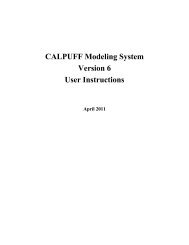Volume 1 - The Atmospheric Studies Group at TRC
Volume 1 - The Atmospheric Studies Group at TRC
Volume 1 - The Atmospheric Studies Group at TRC
You also want an ePaper? Increase the reach of your titles
YUMPU automatically turns print PDFs into web optimized ePapers that Google loves.
• Based on mean performance across all 4 d<strong>at</strong>asets, the prototype model for<br />
OCS applic<strong>at</strong>ions improves upon the previous model designed for OCS<br />
applic<strong>at</strong>ions. It has a small mean bias toward overprediction, and exhibits<br />
sc<strong>at</strong>ter th<strong>at</strong> is typical in th<strong>at</strong> it is close to a factor of two.<br />
• A computed Lagrangian timescale for l<strong>at</strong>eral dispersion produces a<br />
st<strong>at</strong>istically significant factor of two overprediction. Runs with the standard<br />
Draxler Fy curve produce a small overprediction bias th<strong>at</strong> is not st<strong>at</strong>istically<br />
different from zero (MG=1).<br />
• Using modeled Iy in CALPUFF with a minimum σ v of 0.37 m/s produces<br />
less sc<strong>at</strong>ter and slightly smaller overpredictions than using the observed Iy.<br />
Using modeled Iy in CALPUFF with a minimum σ v of 0.5 m/s reduces the<br />
bias and produces a st<strong>at</strong>istically significant underprediction (MG>1) with the<br />
Draxler Fy curves.<br />
• CALPUFF/AERMOD turbulence profile choice produces similar results,<br />
with the AERMOD choice being slightly more conserv<strong>at</strong>ive (larger peak<br />
χ/Q).<br />
Influence of COARE Options in CALMET<br />
Inspection of these results indic<strong>at</strong>es th<strong>at</strong> the choice among COARE options in<br />
CALMET does not have a large influence on model performance. <strong>The</strong> largest<br />
influence on performance appears to be selecting the test algorithm for computing a<br />
Lagrangian timescale for l<strong>at</strong>eral diffusion r<strong>at</strong>her than using the timescale implicit in<br />
the Draxler Fy curves. To better illustr<strong>at</strong>e the effect of the COARE options, results<br />
are collected and processed to form the geometric performance measures for the<br />
subset of CALPUFF configur<strong>at</strong>ions th<strong>at</strong> do not include the computed Lagrangian<br />
timescale (PuffA, PuffB, PuffE and PuffF). Also, we choose to include just the<br />
PuffA and PuffE configur<strong>at</strong>ions th<strong>at</strong> use a minimum σ v of 0.37 m/s. Results of<br />
applying the model evalu<strong>at</strong>ion software, including 95% confidence limits, are listed<br />
in Tables 4-11 through 4-14, and in Figures 4-7 through 4-10.<br />
Inclusion of the COARE module in CALMET/CALPUFF appears to offer a distinct<br />
performance advantage over the original OCD-based overw<strong>at</strong>er flux module. <strong>The</strong><br />
sc<strong>at</strong>ter th<strong>at</strong> is quantified as VG is smaller for all 4 CALPUFF configur<strong>at</strong>ions when<br />
any of the non-zero COARE options is selected, and the difference in VG is<br />
st<strong>at</strong>istically significant for all configur<strong>at</strong>ions except PuffB. Differences in MG<br />
appear smaller, but all of these differences are st<strong>at</strong>istically significant except th<strong>at</strong><br />
between option c0 and c10s for the PuffB configur<strong>at</strong>ion.<br />
Among the COARE options for tre<strong>at</strong>ing wave effects on roughness length, the<br />
shallow w<strong>at</strong>er adjustment to the Charnock parameter (denoted here as 10s) does not<br />
Final Report Vol.1 62







